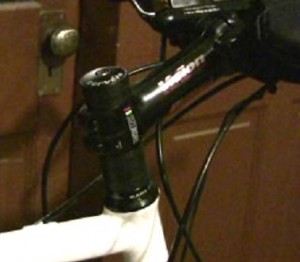Get the Proper Frame Stack, Stop Spacer Abuse!

We’ve all seen it. A lot. Maybe YOU are even guilty of spacer abuse. Yes that’s right, spacer abuse: the egregious stacking of several centimeters of spacers on the carbon steerer tubes of our multi-$K carbon aero tri rockets. “So what” you say – A: The bike came with a fat stack of spacers, and B: I need them to get the “right” position. To which I say – A: so what, your bike also came with nifty reflectors but do you use them? and B: you either have a lousy fit, or you are on the wrong size and/or type of frame, or both.
Why should you care about how many spacers you use? Two reasons: aerodynamics and structural integrity. Have you checked out the newest aero super bikes being used on the Pro Tour these days? One common feature is stemless designs where the handlebars sit right on an integrated frame extension, bayonet or “nose cone”. There are no exposed steerers or round spacers on these bikes. Why? Because nearly vertical cylinders aerodynamically stink. Chances are, your aero bike has a carefully sculpted wind-cheating head tube. Why stack the equivalent of a drag chute on top of it? Cervelo’s Phil Wood told me in Kona 2 years ago that they were fighting to get their pros to stop “sizing down” their TT frames, because they were using too many draggy spacers. Bottom line: best aero= zero spacers.

There is also a structural consideration here. Some manufacturers send warnings with their forks that the maximum exposed steerer tube should be 8cm. This includes approx 1 cm of headset and 4 cm of stem clamp. So max spacers then are 3cm. Otherwise, you are risking a failure which would be decidedly ugly. Kestrel wisely ships their steerers precut so that you can only use 2 cm of spacers. The tri position puts a lot of weight on the handlebars – best not to tempt fate with a monster stack of spacers.
Ok, but what about adjustability? Don’t we need spacers to dial in the front end height? Well, that is the easy way, but not the best way. And you really only have 3cm to play with (really slightly less since your head angle is around 72.5 degrees). So let’s assume you will use ZERO spacers. And also let’s say you need a 10cm stem for the proper reach. How much can we adjust the height of your front end without spacer abuse? Actually, quite a bit.
In a perfect world. you would use a horizontal stem ( also know as a -17 degree stem). This means the wind never “sees” your stem as it hides behind your bars. From there, we could use a -6 degree stem (the most common angle these days) which still keeps most of the stem out of the wind. Going from a -17 to a -6 stem in a 10 cm length raises the front end 2cm. Not bad, considering those ugly spacers only give you 3cm (right?) of adjustment. But wait – there’s more! Most people never even consider using a negative stem. Everyone uses positive stems, so why not consider a negative stem if you need more drop? Bontrager and others make 25 degree stems. Flipped over, they give you about -8 degrees below horizontal. This is about 1.3 cm of drop in a 10cm length. So between the -25 and the -6 stem we have 3.3 cm to play with. Note that your reach is changing a tiny bit with the different angle stems, but only by a few mm. And yes, you could even use up to 1cm of spacer if you wanted to without messing things up too much. So now we have 4.3 cm to play with.
What if you need even more adjustability? You could even go with a 0 degree stem if you had to, giving another cm of rise. Or, you could look at aerobars with different pad heights and spacers. Many aerobar pads sit about 5cm above the stem clamp midline. Others can get as low as 2cm or as high as 6cm. So there you have a few more cm to play with.
Let’s look at the maximum range here without ever touching one of those dirty spacers. A -25 degree stem with a set of Vision Tech base bars (about 2cm of pad stack) as the “low” option and a -6 stem with a set of Vuka clips with a 1cm aero spacer under the pads (about 6cm of pad stack) as the “high” option. The vertical lift range here is a full 7.3 cm. Concede to 1 spacer on the steerer and a 90 deg stem, and the range becomes almost 10cm. That’s should be plenty to play with eh?
So next time you are in the market for a frame, get your contact points dialed in (by a fitter who knows what they are doing) and then look for a frame with the right stack and reach. The “right” stack means zero spacers needed. Remember you are much better off using a drop stem on a higher-stack frame than you are using a big fat stack of spacers on a frame with a too-low stack.
